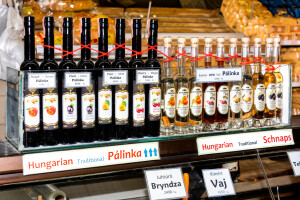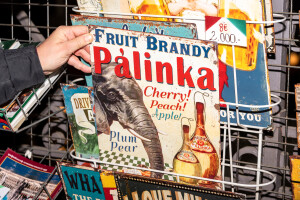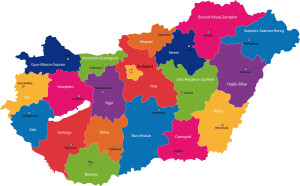Hungary—a landlocked country in Central Europe tucked between Austria, Slovakia, Romania, Ukraine, Slovenia, Croatia, Serbia, and Bosnia—is serious about fruit spirits. So much so that it currently has 13 individual products—various versions of Pálinka—protected as geographical indications (GI) specific to Hungary. With very few exceptions (explained below), Hungary is the only country (under EU laws) that may use the term Pálinka to refer to these products.
The Hungarian lock on the use of the term Pálinka—relatively new by modern standards—was ratified by EU Law LXXIII (based on the EU definition of fruit spirits and often referred to as “pálinka law), passed in 2008.
Prior to this legislation—as far back as the seventeenth century—the term Pálinka was widely used in Central Europe to refer to spirits of many kinds. This included fruit spirits—plum was the most widely used—and grape-based brandy as well as spirits derived from rye, wheat, corn, sugar beets, or buckwheat (among others). The term Pálinka was, for many generations, used somewhat interchangeably with schnapps—a word which still defies strict definition.
These days—per the well-detailed regulations of the Pálinka GI—the term may be used for any fruit-based spirit produced in Hungary. The product specification is quite detailed as to the processing and fermentation of the fruit but does allow for either pot still or column still distillation as well as both unaged and aged expressions. The list of approved base ingredients includes apples, pears, quince, cherries, plums, apricots, peaches, strawberries, raspberries, “wild berries,” and grapes.
The only other country that is allowed to use the term Pálinka is Austria—and the rules regarding Austrian Pálinka are much more specific, quite stringent, and based on historical precedent. For starters, it must be based solely on apricots—no other fruit is allowed. Double distillation in a pot still is mandatory for Austrian Pálinka, and only a few specific regions—Niederösterreich, Burgenland, Styria, and Vienna (Wien) are included in the production zone.
The production of distilled spirits in Central Europe is believed to have begun as far back as the Middle Ages. The first written record referring to Hungarian distillates can be traced back to the year 1330. However, at this time, most of the local spirits were made from wheat, rye, or other grains. Spirits produced from fruit became the leading type of distillate in the region beginning in 1459, when—during a famine—King Mathias forbid the distillation of anything that could be used to make bread. By the 1600s, the term Pálinka—based on the Slavic stem word paliti meaning “to burn” or “to distill”—was used to refer to these spirits.
The first GI for Hungarian Pálinka was awarded in 2003. The latest—Homokháti Őszibarack Pálinka—was approved just last month (March 7, 2022). Homokháti Őszibarack Palinka is described as having a “fine, discreet aroma reminiscent” of ripe peaches, citrus, and a hint of marzipan. It is double-distilled in a pot still using the mash of ripe peaches grown in the Homokhátság—an area located on the flatlands between the Danube and Tisza rivers and known as the Great Sand Ridge.
- The 13 Pálinka geographical indications that have thus far been awarded to Hungary are as follows:
- (Hungarian Fruit): Hungarian Pálinka GI—may be produced throughout Hungary from a range of fruit (typically apples, pears, quinces, plums, apricots, grapes, and/or cherries).
- (Grape Marc): Törkölypálinka GI—Grape marc spirit, may be produced throughout Hungary
- (Quince): Madarasi Birspálinka GI—Quince spirit from Bács-Kiskun County
- (Quince): Nagykunsági Birspálinka GI—Quince spirit from the Nagykunság Region (Jász-Nagykun-Szolnok County)
- (Pear): Vasi Vadkörte Pálinka GI—Pear spirit from Vas and Zala Counties
- (Apple): Szabolcsi Almapálinka GI—Apple spirit from Szabolcs-Szatmár-Bereg County
- (Peach): Homokháti Őszibarack Pálinka GI—Peach spirit from the Homokhátság area (Bács-Kiskun and Csongrad Counties)
- (Sour Cherry): Újfehértói Meggypálinka GI—Sour cherry spirit from Szabolcs-Szatmár-Bereg County
- (Apricot): Gönci Barackpálinka GI—Apricot spirit from the town of Gönc (Borsod-Abaúj-Zemplén County)
- (Apricot): Kecskeméti Barackpálinka GI—Apricot spirit from the Kecskemét Region (Bács-Kiskun County)
- (Plum): Békési Szilvapálinka GI—Plum spirit from the town of Békés (Békés County)
- (Plum): Szatmári Szilvapálinka GI—Plum spirit from Szabolcs-Szatmár-Bereg County
- (Plum): Nagykunsági Szilvapálinka GI—Plum spirit from Jász-Nagykun-Szolnok County
- Similar products/similar terms include:
- Austria (Apricot): Austrian Pálinka GI—Apricot (Barack) Pálinka may be produced in the Austrian regions of Niederösterreich (Lower Austria), Burgenland, Styria, and Vienna (Wien). It should be noted that these regions are located on the eastern edge of Austria, adjacent to the border with Hungary and Slovakia.
- Romania: Romanian Pălincă GI may be produced from any type of fruit grown in Romania. Despite the similarity in the terms, this product is legally distinct from Pálinka.
- Czech Republic, Slovakia: In the Czech Republic and Slovakia, various types of spirits—fruit spirits in particular—are known as Pálenka. This term does not, however, have an official definition nor GI protection.
References/for more information:
- Palinka GI-Hungary and Austria
- Romania-Palinca GI
- Product Specification Homokháti Őszibarack Palinka
- https://www.discoverpalinka.com/magazine
- https://dailynewshungary.com/the-history-of-hungarys-most-famous-alcohol-palinka/
- https://dailynewshungary.com/a-crash-course-on-hungarian-palinka/
- Photo credit: ©rolfgwackenberg/123RF.COM
Post authored by Jane A. Nickles…your blog administrator: jnickles@societyofwineeducators.org


